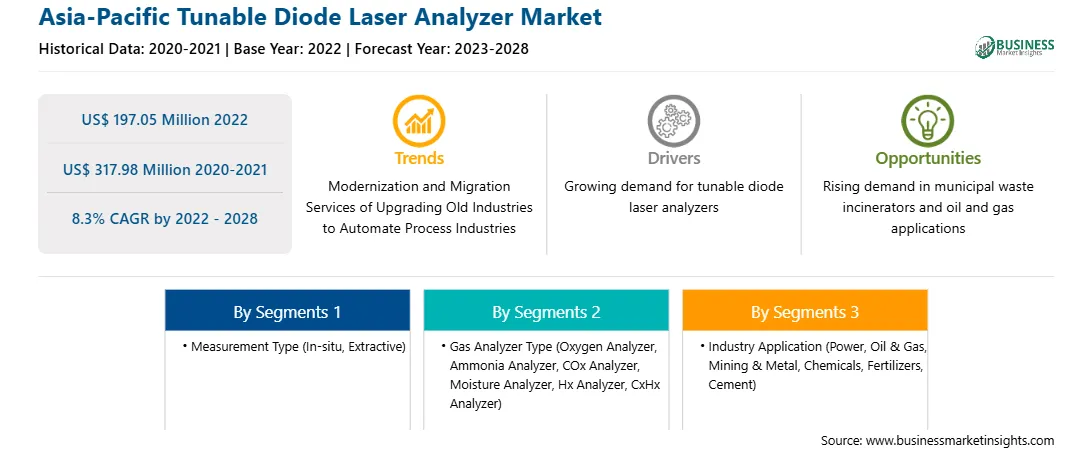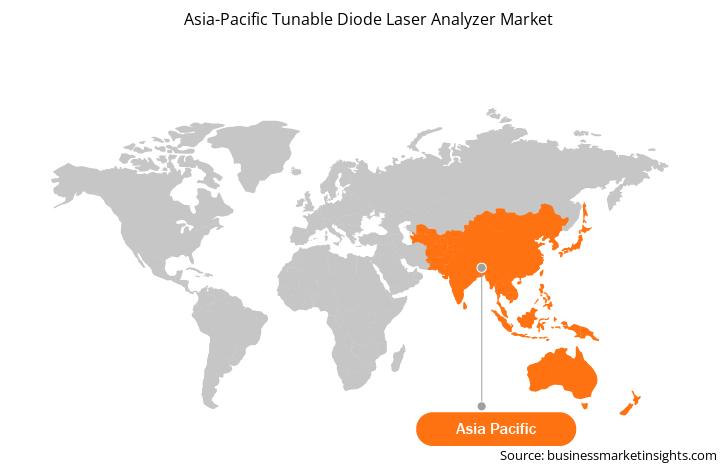The APAC tunable diode laser analyzer market is expected to grow from US$ 197.05 million in 2022 to US$ 317.98 million by 2028; it is estimated to grow at a CAGR of 8.3% from 2022 to 2028.
Rising Demand in Municipal Waste Incinerators and Oil and Gas Applications
Mixed waste is incinerated in municipal waste incinerators (MWI), and the energy generated is used for district heating or power generation. As the humidity of the fuel burned varies, it is critical to keep track of the water vapor in the furnace in real-time. If the fuel is completely burned out, the combustion is efficient, and if too much air is fed into the combustion zone, unnecessary cooling occurs, resulting in lower power generation. Increased Nitrogen oxides (NOx) emissions are also linked to excess air. However, if the plant is operated in an oxygen-deficient environment, Carbon dioxide (CO2) emissions will increase. As a result, optimizing and continuously monitoring the amount of excess air is critical for maintaining an optimal combustion process. In situ oxygen concentration measurements have proven useful for optimizing the combustion process by using tunable diode laser analyzers in the hot combustion zone. Therefore, this is now one of the most common uses for tunable diode laser analyzers in the power industry. The technology rapidly replaces the older zirconia oxide (ZrO2) probes used earlier in the MWI plants. De-nitrification reduction processes remove nitrogen oxides from flue gas and convert nitrogen oxides to nitrogen and water; ammonia or urea is used as a reducing agent. The amount of Ammonia (NH3) used must be sufficient to reduce NOx effectively. However, a large amount of unused NH3 or ammonia should not be allowed to leak downstream in the process. Therefore, the tunable diode laser analyzer in-situ monitoring capability resulted in more accurate and faster NH3 slip measurements. MWI plants have been forced to remove hydrogen chloride (HCl) from flue gases due to increased environmental concerns and regulatory demands. The flue gases are cleaned with hydrated lime in a baghouse filter to reduce HCl emissions. Tunable diode laser analyzers are used to monitor HCl concentrations before and after the baghouse filter. The concentration of HCl in the raw gas before the filter controls the injection of new or re-circulated lime, and the analyzer after the filter verifies the levels emitted from the plant. The removal process is made more efficient, and lime consumption is reduced by using in situ monitoring of the HCl concentration. Reliable process data is directly related to product quality, plant safety, and resource efficiency. As a result, process analytics is an essential component of any modern chemical plant. Process analytical systems are required to provide precise information about product streams' composition, concentration, and purity. Gas chromatographs, infrared gas analyzers, and oxygen paramagnetic measurement analyzers are the analytic tools used. Accurate measuring results are required in any environment, whether under corrosive operating conditions or hazardous areas. Tunable diode laser analyzer technology is still in its early stages of adoption in the chemical and oil & gas industries. However, the technology is quickly gaining traction in certain applications where the TDL's selectivity and quick response time are critical. In the chemical industry, oxygen monitoring is especially important. When oxygen is used in a chemical reaction, its concentration must be kept under control to avoid explosive atmospheres. Safety monitoring is also important in chemical storage facilities. Competing technologies, such as paramagnetic sensors or ZrO2 sensors, face challenges because the environment can contain various gases, many of which are flammable, resulting in large measurement errors. The potential to increase the efficiency and reduce the maintenance of the plants will make tunable diode laser analyzer adoption necessary, thereby driving the market growth across the region.
Market Overview
The APAC Trade Agreement (APTA), formerly known as the Bangkok Agreement, is a preferential regional trade agreement. The adoption of the APAC Trade Agreement (APTA) mutually beneficial trade liberalization measures the contribution to regional trade expansion, and economic cooperation aims to promote its members' economic development. It shifted its focus over time, from initial tariff concessions on merchandise trade to current negotiations on investment, services trade, and trade facilitation. India is part of these agreements; thus, there are opportunities for the vendors operating in the tunable diode laser analyzer market. In China, South Korea, and Japan, with the adoption of smart "Smart Manufacturing" or "Industry 4.0," a significant increase in flexibility in enhancing the manufacturing facility and the adoption of process automation technologies is further increasing the production. Emerging countries such as India and China are growing process automation in various industries and favorable government policies such as "Made in China 2025, Make in India, Production-linked incentive (PLI) scheme, and SAMARTH Udyog Bharat 4.0. In 2021, The Indian Ministry of Heavy Industries announced the launch of the Samarth Udyog Bharat 4.0 initiative, which aims to accelerate the adoption of process automation and innovative technologies in India's manufacturing sector by the end of 2025. These government initiatives are supporting the growth of the manufacturing production facilities, positively impacting the tunable diode laser analyzer market in the APAC. The demand for industrial robots in various process manufacturing facilities is increasing, and with the rising urbanization, many manufacturing production plants are planning to expand their footprints domestically and internationally. Thus, with the establishment of new manufacturing production plants, the demand for tunable diode laser analyzers is also increasing.
APAC Tunable Diode Laser Analyzer Market Revenue and Forecast to 2028 (US$ Million)
Strategic insights for the Asia-Pacific Tunable Diode Laser Analyzer provides data-driven analysis of the industry landscape, including current trends, key players, and regional nuances. These insights offer actionable recommendations, enabling readers to differentiate themselves from competitors by identifying untapped segments or developing unique value propositions. Leveraging data analytics, these insights help industry players anticipate the market shifts, whether investors, manufacturers, or other stakeholders. A future-oriented perspective is essential, helping stakeholders anticipate market shifts and position themselves for long-term success in this dynamic region. Ultimately, effective strategic insights empower readers to make informed decisions that drive profitability and achieve their business objectives within the market. The geographic scope of the Asia-Pacific Tunable Diode Laser Analyzer refers to the specific areas in which a business operates and competes. Understanding local distinctions, such as diverse consumer preferences (e.g., demand for specific plug types or battery backup durations), varying economic conditions, and regulatory environments, is crucial for tailoring strategies to specific markets. Businesses can expand their reach by identifying underserved areas or adapting their offerings to meet local demands. A clear market focus allows for more effective resource allocation, targeted marketing campaigns, and better positioning against local competitors, ultimately driving growth in those targeted areas.Asia-Pacific Tunable Diode Laser Analyzer Strategic Insights

Asia-Pacific Tunable Diode Laser Analyzer Report Scope
Report Attribute
Details
Market size in 2022
US$ 197.05 Million
Market Size by 2028
US$ 317.98 Million
Global CAGR (2022 - 2028)
8.3%
Historical Data
2020-2021
Forecast period
2023-2028
Segments Covered
By Measurement Type
By Gas Analyzer Type
By Industry Application
Regions and Countries Covered
Asia-Pacific
Market leaders and key company profiles
Asia-Pacific Tunable Diode Laser Analyzer Regional Insights

APAC Tunable Diode Laser Analyzer Market Segmentation
The APAC tunable diode laser analyzer market is segmented based on measurement type, gas analyzer type, industry application, and country.
ABB Ltd, Axetris AG, Boreal Laser Inc, Emerson Electric Co., METTLER TOLEDO, NEO Monitors AS, Siemens AG, Teledyne Analytical Instruments, Unisearch Associates Inc, and Yokogawa Electric Corporation are among the leading companies in the APAC tunable diode laser analyzer market.
The Asia-Pacific Tunable Diode Laser Analyzer Market is valued at US$ 197.05 Million in 2022, it is projected to reach US$ 317.98 Million by 2028.
As per our report Asia-Pacific Tunable Diode Laser Analyzer Market, the market size is valued at US$ 197.05 Million in 2022, projecting it to reach US$ 317.98 Million by 2028. This translates to a CAGR of approximately 8.3% during the forecast period.
The Asia-Pacific Tunable Diode Laser Analyzer Market report typically cover these key segments-
The historic period, base year, and forecast period can vary slightly depending on the specific market research report. However, for the Asia-Pacific Tunable Diode Laser Analyzer Market report:
The Asia-Pacific Tunable Diode Laser Analyzer Market is populated by several key players, each contributing to its growth and innovation. Some of the major players include:
The Asia-Pacific Tunable Diode Laser Analyzer Market report is valuable for diverse stakeholders, including:
Essentially, anyone involved in or considering involvement in the Asia-Pacific Tunable Diode Laser Analyzer Market value chain can benefit from the information contained in a comprehensive market report.